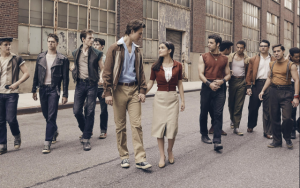WEST SIDE STORY: 4 STARS. “a reinvention with energy and lots of finger snapping.”
The list of films Hollywood considers sacred and untouchable is a short one. Only a bugger for punishment would attempt a redo of “The Godfather.” And imagine the jeers that would accompany the announcement of a reimagined “Casablanca” or “Do the Right Thing.”
Until recently I would have put “West Side Story,” the classic 1961 musical that won ten Academy Awards, in the top five of films on the No Go list. But just as that show riffed on “Romeo and Juliet,” a classic if there ever was one, Steven Spielberg takes another look at a memorable movie the TCM crowd considers untouchable.
Set in 1950s New York City, the story of love at first sight is plays out against a backdrop of the gentrification of the Upper West Side, a then blue-collar neighborhood. Two gangs, the Puerto Rican Sharks and the Jets, the “Last of the Can’t Make It Caucasians,” run the streets as the NYC Department of Slum Clearance chop up their home turf. The only thing they have in common is a “womb to tomb” membership motto.
Into this comes Tony and Maria (Ansel Elgort and newcomer Rachel Zegler), star-crossed lovers whose infatuation causes friction between the gangs. “You’re going to start World War III,” says Anita (Ariana DeBose).
Tony’s best friend Riff (Mike Faist) runs the nativist white Jets—“Everything is being taken over by people I don’t like,” he sneers.—while Maria’s brother Bernardo (David Alvarez) leads the Sharks.
Tony is on parole for almost beating a boy to death in a rumble, but has turned over a new leaf. “I want to unlike myself,” he says, “because I was headed to the sewer.” He also puts to rest the notion that “once you’re a Jet, you’re a Jet all the way.” He wants out of that life, but most of all, he wants Maria.
As Riff and Bernardo plan a rumble to viciously work out their differences, Maria begs Tony to put an end to the violence. “We can’t pretend what we do didn’t cause this trouble,” she says. Tony intervenes, but the situation quickly spirals out of control.
Steven Spielberg’s take on “West Side Story” feels rooted in the tradition of movie musicals but vibrates with current themes. The social mindfulness that was revolutionary for musical theatre in the 1950s Broadway run is present and expanded on. Tony Kushner’s script offers context and backstories for underdeveloped characters and plays on hot button themes of racial animus, poverty and violence.
Most of all, however, it’s about love.
It’s love that causes all the trouble but also gives the movie its beating heart. As the couple in question Elgort and Zegler are appealing, wide-eyed romantic figures. Zegler is a convincing swirl of determination and innocence, with a beautiful voice. Elgort can wrap his mouth around Stephen Sondheim’s lovely lyrics—”Maria, say it loud and there’s music playing. Say it soft and it’s almost like praying”—but doesn’t shine as bright as some of his co-stars.
As Bernardo, Alvarez brings the menace, smooth charm and athletic dance moves to steal his scenes. Faist also impresses as hardheaded gang leader Riff. DeBose gives a high stepping performance as Bernardo’s girlfriend Anita, a role that grows more poignant in the movie’s third act.
But it’s a returning cast member from the 1961 film who gives the movie its soul.
Rita Moreno won an Oscar for playing Anita in the original. Here she plays drug mart operator Valentina. Kushner expands the role, making the character the conscience of the neighborhood. She is luminous in the part, and, in a major departure from the 1961 film, does a solo rendition of “Somewhere,” a song of hope usually sung by the romantic leads. Here it is devastating, played as song of longing and loss. If my goosebumps voted for the Academy Awards, Moreno would have another statue to put on her shelf.
“West Side Story” is Spielberg’s most compelling film in years. It reinvents, reimagines and recontextualizes a classic story with energy, respect and lots of finger snapping.

